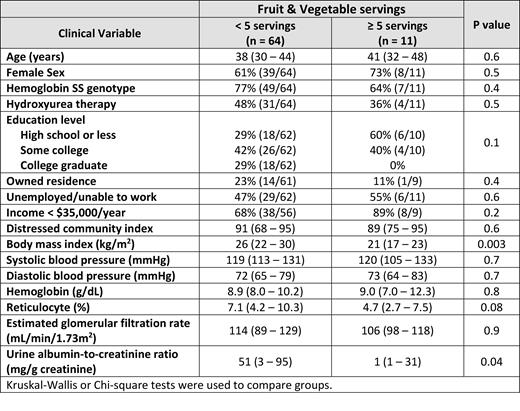Introduction
Patients with sickle cell disease (SCD) experience frequent disruptions to their daily lives from vaso-occlusive pain episodes and chronic organ complications, such as stroke. These acute and chronic complications negatively impact patients' ability to continue their educational and occupational obligations, making them vulnerable to socioeconomic challenges (PMID 30540112). In children with SCD, individual-level socioeconomic distress was associated with poor diet quality (PMID 34811867). In the non-SCD literature, food insecurity is characterized by a low fruit and vegetable diet intake and a greater risk of chronic kidney disease (PMID 24434743). The association of individual level socioeconomic distress with fruit and vegetable intake and, in turn, of fruit and vegetable intake with kidney function in adults with SCD is unclear.
Methods
We prospectively surveyed adults with SCD to investigate the association between individual level socioeconomic distress, fruit and vegetable intake, and kidney function. Between July 2022 and June 2023, we enrolled 81 adults with a diagnosis of SCD from an outpatient clinic at a Sickle Cell Center in an urban academic institution. We assessed fruit and vegetable intake using the National Cancer Institute's All Day Screener, a validated tool that estimates daily intake of fruit and vegetables. Markers of socioeconomic distress were measured using a modified short quantitative survey created by adapting the Centers for Disease Control's Behavioral Risk Factor Surveillance System Questionnaire. The distressed community index (DCI), a composite indicator that estimates the economic well-being of a community, was determined for each patient's residential address. The data were analyzed using descriptive statistics, and the association of fruit and vegetable intake with body mass index and kidney function was determined using linear regression, adjusting for age, sex, and SCD genotype.
Results
The median age of the cohort was 38 years (interquartile range [IQR], 31 - 45 years), 60% were female, 74% had Hb SS or Sβ 0-thalassemia genotype, and 47% were on hydroxyurea therapy. The median BMI of the cohort was 25 kg/m 2 (IQR, 21 - 30 kg/m 2). With respect to socioeconomic indicators, 33% (25/75) had high school or less education, 80% (59/74) did not own their residence, 48% (37/77) were unemployed or unable to work, and 71% (49/69) had income of < $35,000/year. The median DCI for our cohort was 90.8 (IQR, 68.9 - 94.9) with 65% (52/81) living in a distressed community (DCI > 80).
The median fruit and vegetable servings consumed by the cohort was 1.95 serving sizes per day (IQR 1.05-3.04 servings), which is lower than the Centers for Disease and Control (CDC) Prevention daily dietary recommendation of 5 servings per day, and below the national and state-level (Illinois) average of 2.6 servings per day in the general population (PMID 34990439). Only 15% (11/75) of our cohort met the CDC daily recommendations of fruits and vegetables. Baseline demographics, including age, sex, SS/Sβ 0-thalassemia genotype, and hydroxyurea therapy use, were not different between those that met versus did not meet the daily fruit and vegetable intake requirements (Table). Similarly, we did not observe any differences in the socioeconomic indicators, DCI score, or proportion of patients living in a distressed tier in these two groups.
On multivariable analyses, lower fruit and vegetable intake was associated with higher body mass index (natural log β 0.08 ± 0.03; P = 0.001) and higher urine albumin to creatinine ratios (natural log β 0.41 ± 0.2; P = 0.045). We did not observe any association of fruit and vegetable intake with systolic or diastolic blood pressure or with estimated glomerular filtration rate.
Discussion
In this prospective, cross-sectional study, adults with SCD experienced a high burden of socioeconomic distress. Although we did not observe an association between socioeconomic indicators and fruit and vegetable intake, only 15% of our cohort met the daily fruit and vegetable intake recommendations. Lower fruit and vegetable intake was associated with higher body mass index and albuminuria. Our findings highlight the need for further investigation to better understand barriers to a healthy diet in people with SCD. Furthermore, strategies to increase fruit and vegetable intake may represent a modifiable risk factor to improve SCD-related health.
Disclosures
Gordeuk:CSL-Behring: Consultancy; Emmaus: Consultancy, Research Funding; Modus Therapeutics: Consultancy; Novartis: Research Funding; Forma: Consultancy, Research Funding; GBT/Pfizer: Consultancy, Research Funding; Incyte: Research Funding; Takeda: Consultancy. Saraf:Novartis: Consultancy, Other: Advisory board, Research Funding; Agios: Consultancy, Other: Advisory board; GBT/Pfizer: Consultancy, Other: Advisory board, Research Funding, Speakers Bureau; Forma Therapeutics: Consultancy, Other: Advisory board, Research Funding; BEAM Therapeutics: Consultancy, Other: Advisory board.


This feature is available to Subscribers Only
Sign In or Create an Account Close Modal